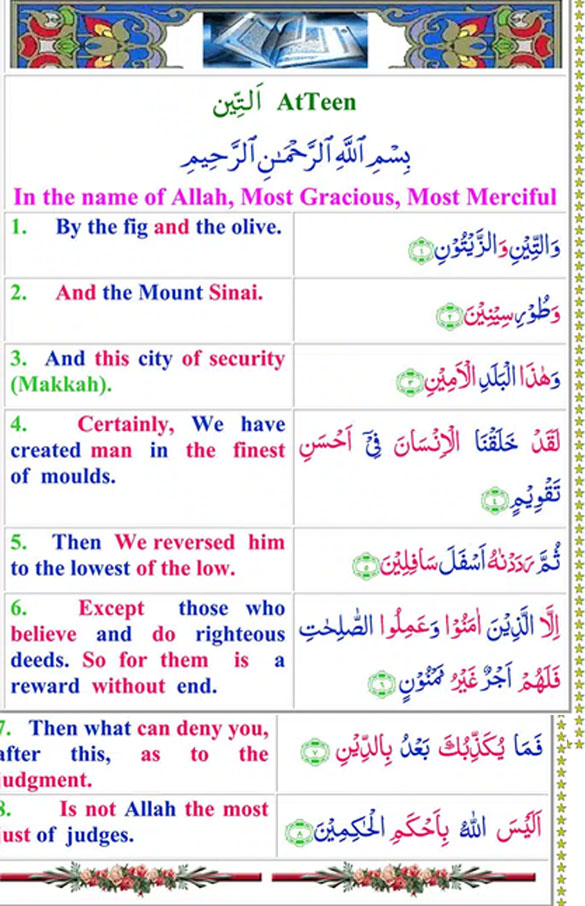Tafsir on the Surah At-Tin (The Fig)

By Naseer Ahmed, New Age Islam
28 August 2024
(95:1) By the Fig and the Olive,
(2) And the Mount of Sinai,
(3) And this City of security,-
(4) We have indeed created man in the best of moulds,
(5) Then do We abase him (to be) the lowest of the low,-
(6) Except such as believe and do righteous deeds: For they shall have a reward unfailing.
(7) Then what can, after this, contradict thee, as to the judgment (to come)?
(8) Is not Allah the wisest of judges?

The Surah begins with an adjuration to the Messengers of Allah who founded Allah’s religion. These Messengers, chosen by Allah, played a crucial role in spreading His message and guiding humanity. The City of Security is Mecca, a sanctuary from the days of Ibrahim (AS) where Muhammad (PBUH) lived, first received revelations and began preaching Islam. Mount Sinai is the mountain on which Allah spoke to Moses, making him a prophet and sending him on a mission to the Pharaoh; Olive refers to the Mount of Olives associated with Jesus. The Fig or the Fig Tree is held holy in almost all religious traditions, including Buddhism, Hinduism, and Jainism. It, therefore, most likely refers to all the remaining unnamed Messengers of Allah and founders of religious sects talked about in the following verses:
(10:47) To every people (was sent) a messenger: when their messenger comes (before them), the matter will be judged between them with justice, and they will not be wronged.
(14:4) We sent not a messenger except (to teach) in the language of his (own) people, in order to make (things) clear to them. Now Allah leaves straying those whom He pleases and guides whom He pleases: and He is Exalted in power, full of Wisdom.
What is common to all is:
(21:25) Not a messenger did We send before thee without this inspiration sent by Us to him: that there is no god but I; therefore worship and serve Me.
There are differences too:
(5:48) ....To each among you have we prescribed a law and an open way. If Allah had so willed, He would have made you a single people, but (His plan is) to test you in what He hath given you: so strive as in a race in all virtues. The goal of you all is to Allah; it is He that will show you the truth of the matters in which ye dispute;
What is the best of moulds that is being referred to? The 17th-century astronomer Johannes Kepler said, "God created us after His image so that we could share in His thoughts." Never have truer words been spoken. We cannot know God unless God gives us some part of His attributes. We cannot know what Rahman, Rahim, Ghafoor, Shakoor, Adl, etc., mean unless we have some small part of the same attributes. No other creature has been created in the same mould. God has created us in the best of moulds for a purpose.
To remain godly, Allah has given us His religion to follow through His Messengers by whom the Surah swears. It swears by those messengers to confirm the message they communicated and because they will be witnesses for and against their people on the Day of Judgment. See verse 10:47 above and :(39:69) …. the prophets and the witnesses will be brought forward and a just decision pronounced between them; and they will not be wronged (in the least).(70) And to every soul will be paid in full (the fruit) of its Deeds; and (Allah) knoweth best all that they do”. Every nation will be judged by the Message their prophet brought them which is why the prophets will be witnesses for their people.
Those who follow Allah’s religion believe and do righteous deeds and are covered in verse 95:6. The rest are those who are debased to the lowest of low, meaning lower than animals who will be punished. The lack of belief in Allah and the judgment to come is symptomatic of a deeper malaise which drags a person to the lowest of low. These are people without integrity. On the Day of Judgment, no one will be able to lie, and these people will stand condemned by their tongue.
Then what can, after this narration, make you doubt the judgment to come?
Footnote 1:
Significance of the Fig Tree in various religious traditions:
The fig tree is held sacred in several religious traditions across the world, each with its own significance. Here's a list of major traditions and the role of the fig tree in each:
1. Buddhism
• Sacred Fig Tree (Bodhi Tree): The Bodhi Tree, a species of fig tree (Ficus religiosa), is of utmost significance in Buddhism. It is under this tree that Siddhartha Gautama attained enlightenment and became the Buddha. The tree represents enlightenment, wisdom, and the awakening of spiritual insight.
2. Hinduism
• Peepal Tree (Ashvattha or Ficus religiosa): In Hinduism, the Peepal tree is considered sacred and is often associated with the gods Vishnu and Shiva. It is believed that the tree embodies the trinity of Brahma (roots), Vishnu (trunk), and Shiva (leaves). The Peepal tree is worshipped in various rituals, especially by women seeking fertility, health, and good fortune.
• Symbol of Immortality: The tree is also seen as a symbol of immortality, and in some traditions, it is believed that gods reside within it.
3. Christianity
• Fig Tree in the Bible: The fig tree appears multiple times in the Bible, symbolizing abundance, prosperity, and spiritual wellbeing. In the New Testament, Jesus curses a barren fig tree, which some interpret as a metaphor for the importance of bearing spiritual fruit. The fig tree is also associated with the idea of peace and security, as sitting under one's own fig tree is mentioned as a sign of prosperity (e.g., Micah 4:4).
• Tree of Knowledge: Some traditions speculate that the Tree of Knowledge in the Garden of Eden may have been a fig tree, as Adam and Eve covered themselves with fig leaves after the Fall.
4. Judaism
• Symbol of National Security and Prosperity: In Jewish tradition, the fig tree is often a symbol of peace and prosperity. The Bible references the fig tree multiple times, particularly in the context of a peaceful and secure life (e.g., 1 Kings 4:25). The fig tree is also associated with the study of Torah, with some interpretations suggesting that the fruit represents knowledge and the leaves protection.
5. Islam
• Mentioned in the Quran: The fig tree is mentioned in the Quran (Surah At-Tin, Chapter 95:1), where Allah swears by the fig and the olive, indicating their significance. The fig is associated with nourishment, health, and is often seen as a symbol of natural bounty.
• Fig Tree as a Blessed Tree: While not directly worshipped, the fig tree is respected for its physical benefits and the spiritual significance conferred by its mention in the Quran.
6. Ancient Egyptian Religion
• Sycamore Fig (Ficus sycomorus): In ancient Egypt, the sycamore fig tree was associated with the goddess Hathor and considered sacred. It was believed to be a bridge between life and death, often depicted in tomb art as providing sustenance to the deceased in the afterlife. The tree was also seen as a symbol of protection and regeneration.
7. Baha'i Faith
• Symbol of Prosperity: In the Baha'i Faith, the fig tree is mentioned in the sacred writings and is considered a symbol of prosperity and spiritual abundance. It is often used metaphorically to describe the flourishing of the human soul and society.
8. Jainism
• Associated with Sacred Sites: The fig tree, particularly the Banyan (Ficus benghalensis) and the Peepal (Ficus religiosa), holds a place of reverence in Jainism. It is believed that several Tirthankaras, or spiritual teachers, attained enlightenment under these trees, similar to the Buddha in Buddhism.
9. African Traditional Religions
• Sacred Groves: In some African traditional religions, fig trees are considered sacred and are often found in sacred groves. These trees are believed to house spirits or be associated with ancestors, and rituals are conducted under them to communicate with these spiritual entities.
10. Greco-Roman Mythology
• Symbol of Fertility and Peace: In ancient Greek and Roman cultures, the fig tree was associated with fertility and was sacred to Dionysus (Bacchus in Roman mythology), the god of wine and festivity. The tree was also seen as a symbol of peace and prosperity.
11. Zoroastrianism
• Tree of Life: In some Zoroastrian traditions, a mythological tree called "Haoma" is sometimes associated with the fig tree. This tree is considered a source of life and immortality, though the fig tree itself is not specifically worshipped in Zoroastrian rituals.
12. Shinto (Japan)
• Divine Symbolism: In Shinto, the native religion of Japan, certain fig species, like the Japanese fig (Ficus carica), are revered as having divine properties, often associated with fertility and abundance. Ritual offerings are sometimes made to fig trees.
Each of these traditions recognizes the fig tree for its symbolic, spiritual, or ritual significance, making it one of the most universally revered trees across different cultures and religions.
Footnote 2:
Non-Abrahamic Prophets
Some of the prophets mentioned in the Quran who preceded Abraham are Idris, Noah, Hud, and Saleh. The Quran also endorses the Sabians' religion, which is “non-Abrahamic” and indeed “any who believe in God and the Last Day, and work righteousness”.
(2:62) Those who believe (in the Qur´an), and those who follow the Jewish (scriptures), and the Christians and the Sabians,- any who believe in Allah and the Last Day, and work righteousness, shall have their reward with their Lord; on them shall be no fear, nor shall they grieve.
Also consider verse 5:48 “We have prescribed to each of you a law and a clear way. If God had desired, he could have made you a single community. Instead, he is testing you with regard to the revelations you received. So, compete in doing good. You will all return to God, and he will inform you then concerning those things about which you argued”. This suggests that non-Abrahamic traditions can be very different. It should not therefore shock or surprise us if Buddhism is also endorsed.
Who are the Sabians?
The Quran doesn't speak much about the Sabians except to say they will be entitled to Heaven in verses 2:62 and 5:69. People have speculated who they are. Some scholars believe it is impossible to establish their original identity with any degree of certainty.
From the early tenth century, the term 'Sabian' was applied to purported 'pagans', such as ancient Egyptians and Greeks or Buddhists. Ibn Wahshiyya (died c. 930) used the term for Mesopotamian paganism that preserved elements of ancient Assyro-Babylonian religion.
Sabian may be a placeholder for all other ancient sects with a solid moral code. It may include Buddhists, Parsis, the Yazidis, the Druze, and any remnants of the followers of the Hammurabi code.
The Fig in Surah 95 refers to the unnamed Messengers and Sabians to their people. It would, therefore, be incorrect to interpret “The Fig” as referring only to the Buddha as I have done in my previous articles.
-----
A frequent contributor to NewAgeIslam.com, Naseer Ahmed is an Engineering graduate from IIT Kanpur and is an independent IT consultant after having served in both the Public and Private sector in responsible positions for over three decades. He has spent years studying Quran in-depth and made seminal contributions to its interpretation.
URL: https://www.newageislam.com/debating-islam/tafsir-surah-at-tin-fig/d/133064
New Age Islam, Islam Online, Islamic Website, African Muslim News, Arab World News, South Asia News, Indian Muslim News, World Muslim News, Women in Islam, Islamic Feminism, Arab Women, Women In Arab, Islamophobia in America, Muslim Women in West, Islam Women and Feminism
